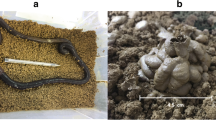Summary
Microbial respiration, microbial biomass and nutrient requirements of the microflora (C, N, P) were studied in the food substrate (soil taken from the upper 3 cm of the mineral soil of a beech wood on limestone), the burrow walls and the casts of the earthworm Aporrectodea caliginosa (Savigny). The passage of the soil through the gut caused an increase in soil microbial respiration of about 90% over a 4-week period. Microbial biomass was increased only in freshly deposited casts and decreased in aging faeces to a level about 10% lower than in soil. Microbial respiration of the burrow walls was only increased over a shorter period (about 2 weeks). The microflora of the soil and the burrow walls was limited by P, whereas in earthworm casts, microbial growth was limited by the amount of available C. In aging faeces the P requirement of the microflora increased and approached that of the soil. Immobilization of phosphate in earthworm casts is probably caused by mainly abiotic processes. C mineralization by soil microflora fertilized with glucose and P was limited by N, except in freshly deposited casts. Ammonium, not nitrate, was responsible for this process. N dynamics in earthworm casts are discussed.
Similar content being viewed by others
References
Aldag, R, Graff O (1975) N-Fraktionen in Regenwurmlosung and deren Ursprungsboden. Pedobiologia 15:151–153
Anderson JPE, Domsch KH (1978) A physiological method for the quantitative measurement of microbial biomass in soils. Soil Biol Biochem 10:215–221
Atlavinyte O, Lugauskas A (1971) The effect of Lumbricidae on soil microorganisms. Ann Zool Ecol Anim, Spec Publ 4:73–80
Darwin C (1881) The formation of vegetable mould through the action of worms, with observations on their habits. Murray, London
Day GM (1950) Influence of earthworms on soil microorganisms. Soil Sci 69:175–184
Domsch KH, Banse HJ (1972) Mykologische Untersuchungen an Regenwurmexkrementen. Soil Biol Biochem 4:31–38
Evans AC (1947) A method for studying the burrowing activities of earthworms. Ann Mag Nat Hist 14:1–13
Evans AC (1948) Studies on the relationships between earthworms and soil fertility II. Some effects of earthworms on soil structure. Ann Appl Biol 35:1–13
Graff O (1971) Stickstoff, Phosphor und Kalium in der Regenwurmlosung auf der Wiesenfläche des Sollingprojektes. Ann Zool Ecol Anim, Spec Publ 4:503–512
Kollmannsperger F (1952) Über die Bedeutung der Regenwürmer für die Fruchtbarkeit des Bodens. Decheniana 105/106:165–187
Kozlovskaya LS (1969) Der Einfluß der Exkremente von Regenwürmern auf die Aktivierung der mikrobiellen Prozesse in Torfboden. Pedobiologia 9:158–164
Kulinska D (1961) The effect of earthworms on the soil microflora (Polish with English summary). Acta Microbiol Pol 10:339–346
Lee KE (1985) Earthworms. Their ecology and relationships with soils and land use. Academic Press, Sydney
Ottow JCG, Fabig W (1984) Einflulβ der Sauerstoffbegasung auf die Denitrifikationsintensität (aerobe Dentrifikation) und das Redoxniveau unterschiedlicher Bakterien. Landwirtsch Forsch 37:453–470
Parle JN (1963a) A microbiological study of earthworm casts. J Gen Microbiol 31:13–22
Parle JN (1963b) Micro-organisms in the intestine of earthworms. J Gen Microbiol 31:1–11
Ponomareva SJ (1962) Die Bedeutung der biologischen Faktoren für die Steigerung der Fruchtbarkeit rasenpodsoliger Böden. Z Pflanzenernähr Bodenkd 97:205–215
Runge M (1970) Untersuchungen zur Bestimmung der Mineralstickstoffnachlieferung am Standort. Flora Abt B 159:233–257
Satchell JE (1967) Lumbricidae. In: Burges A, Raw F (eds) Soil biology. Academic Press, London, pp 259–322
Satchell JE, Martin K (1984) Phosphatase activity in earthworm faeces. Soil Biol Biochem 16:191–194
Scheu S (1987a) The role of substrate feeding earthworms (Lumbricidae) for bioturbation in a beechwood soil. Oecologia (Berlin) 72:192–196
Scheu S (1987b) The influence of earthworms (Lumbricidae) on the nitrogen dynamics in the soil litter system of a deciduous forest. Oecologia (Berlin) 72:197–201
Sharpley AN, Syers JK (1977) Seasonal variation in casting activity and the amounts and release to solution of phosphorus forms in earthworm casts. Soil Biol Biochem 9:227–231
Stöckli A (1928) Studium fiber den Einfluß des Regenwurmes auf die Beschaffenheit des Bodens. Landwirtsch Jahrb Schweiz 42:1–121
Author information
Authors and Affiliations
Rights and permissions
About this article
Cite this article
Scheu, S. Microbial activity and nutrient dynamics in earthworm casts (Lumbricidae). Biol Fert Soils 5, 230–234 (1987). https://doi.org/10.1007/BF00256906
Received:
Issue Date:
DOI: https://doi.org/10.1007/BF00256906




